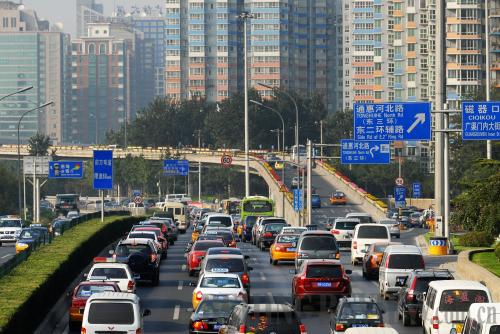|
 |
|
NOISY HIGHWAY: Residential buildings stand close to a busy and noisy highway in Beijing (CFP) |
It was a beautiful day in Beijing's Haidian District. Ms. Wang was about to open the window for a breath of fresh air, but as soon as she did, the rumbling of passing vehicles drowned out the sound of her TV.
The window of her high-rise apartment faces a highway leading to the Badaling section of the Great Wall in the city's northern suburb. While this traffic artery gives people easy access to the famous tourist destination, its noise troubles those living too close.
Wang's home is about 50 meters from the highway. A garden lies between the highway and residential buildings in the community. Wang said that the trees may divert some of the noise from reaching lower levels of the buildings, but honking horns and rumbling engines still vex the upper levels.
Wang said that the noise was tolerable when she moved into the community in 2004, but it has worsened as traffic has become denser.
At night, the racket grows even louder as heavy trucks enter the city via the highway. Local residents said that they sometimes were awaken by blaring horns.
According to the Beijing Municipal Environmental Protection Bureau, the community's noise level reaches 75.3 decibels during the day and 76.1 decibels at night. Both figures exceed the national acoustic environment standards of 70 decibels during the day and 55 decibels at night for sound-sensitive venues such as hospitals, schools, research institutes and residential buildings at roadside.
High-volume noise is known to cause various health problems such as hearing impairment, cardiovascular diseases, lower cognitive ability and anxiety.
Noise pollution is the second most complained about form of pollution in China, according to the China Environmental Noise Prevention and Control Report released by the Ministry of Environmental Protection (MEP) in February. The report shows that 36 percent of all the letters received by environment protection authorities in the country complain about noise pollution.
Noise levels beside urban roads at night tend to be high in China. In 2010, noise stayed under the national standard in only 37.3 percent of the monitored urban road sections in the country, the report said.
Road noise monitoring is conducted at points on pedestrian walks 20 cm from the closest automobile lanes, away from other non-traffic noise sources and usually at least 50 meters from an intersection.
Large cities such as Beijing are faced with surging traffic volume, denser subway lines and more and more frequent air flights. The sound of traffic has disturbed many residents.
On February 16, the Beijing Traffic Management Bureau announced that Beijing's automobile ownership reached 5.015 million, and more than 90 percent of the roads in the city were saturated or super-saturated.
About 1 million Beijing residents are exposed to noise pollution along major roads, according to the Beijing Municipal Environmental Protection Bureau.
Some residents once surveyed the traffic volume of a section of the Beijing-Tibet Highway between Shangqing, Qinghe and Xiaoying bridges in Haidian District at 9:20 a.m., and found that within a minute, about 350 automobiles passed, each contributing to disturbing levels of noise.
Noise can be reduced at the source, in the transmission process, and at the reception end. According to experts, measures to buffer noise during transmission include setting up noise barriers and green belts, as well as adopting soundproof design and sound-insulating doors and windows to protect noise-sensitive buildings. To control traffic noise at the source, such measures as improving vehicle design, enhancing road maintenance and imposing restrictions on horn use should also be taken.
| 